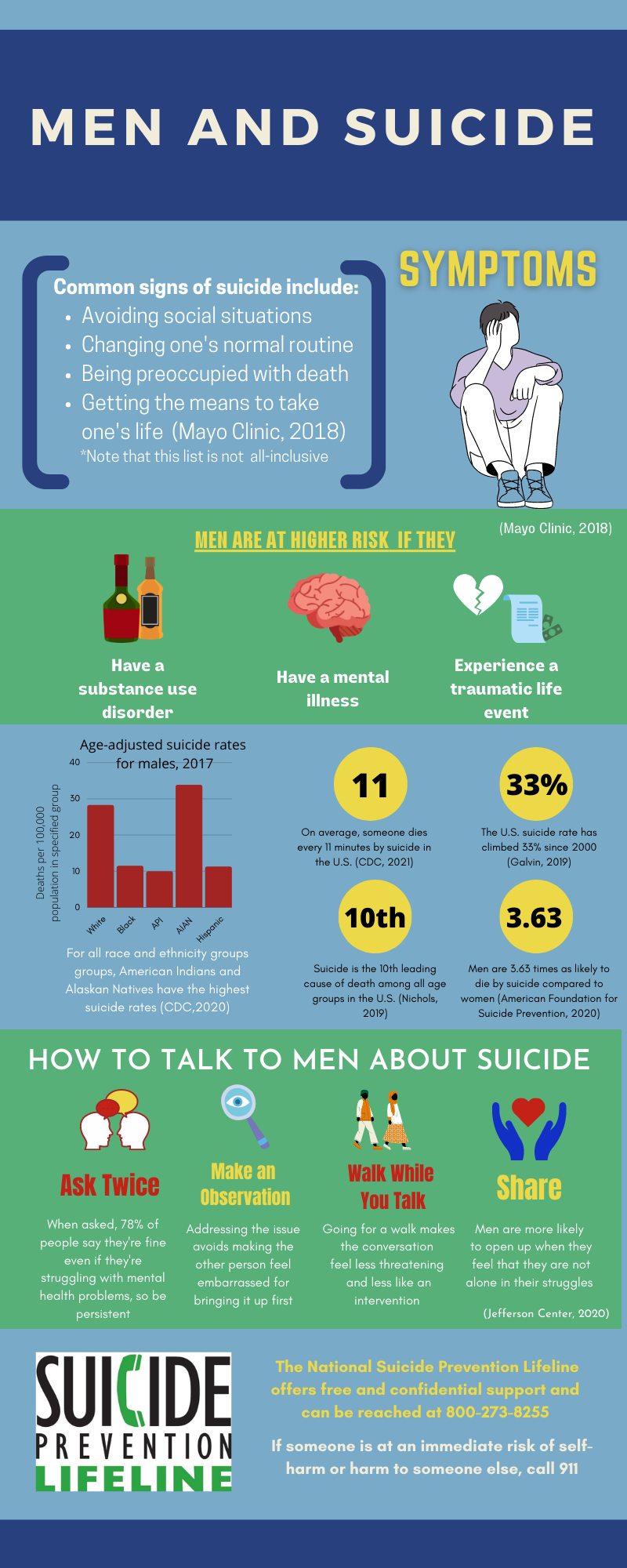19 Suicide
Taylor Scott
Introduction
Suicide is a serious public health problem that affects millions of people each year. It is the second leading cause of death for people ages 10-34 years and the 10th leading cause of death among all age groups in the United States (Nichols, 2019). Men experience suicide at much higher rates than women, so it is important to understand the impact of gender norms on suicide rates (Jordan & Chandler, 2019). While more attention has been given to suicide and mental health in recent years, suicide rates continue to climb and more needs to be done. By educating people about the signs of suicide, who are most at risk, and how to talk about mental health, people can get the help they need before it is too late.
Symptoms

When discussing symptoms of suicide, it is important to remember that warning signs are not always obvious and can vary from person to person. While some people make their intentions clear, others keep their suicidal thoughts a secret. Among males, specifically, a study by Aislinné Freeman (2017) found that common triggers for suicidal thoughts and attempts include being single, retirement, and unemployment. Men are also more likely than women to cope with drugs and alcohol. An increase in substance use and risky behaviors are often seen in men struggling with suicidal thoughts (Leonard, 2020). According to the Mayo Clinic (2018), other signs someone is considering suicide include talking about suicide, avoiding social situations, and getting the resources to take one’s life (buying a gun, stockpiling pills, etc.). Someone who is struggling may also start to change their normal routine, experience mood swings, and say goodbye to people as if they will not see them again. Being preoccupied with death or talking about death, including statements like “I wish I were dead” or “I’m going to kill myself,” should be considered a mental health emergency. In such situations, medical personnel should become involved and the individual should be monitored to ensure their safety.
Risk Factors
When someone commits suicide, it is not always clear why they decided to take their own life, and there is often no single cause. Risk factors listed by the Mayo Clinic (2018) include previously attempting suicide, experiencing a stressful life event (loss of loved one, financial problems, breakup, etc.), and having an underlying psychiatric disorder. Additionally, having a family history of mental health disorders, suicide, violence, or substance abuse also puts an individual at an increased risk. Risk factors can also look different in younger and older people. What may seem like a minor problem to an adult, such as school problems or a loss of a friendship, could be seen as devastating to a child or teen. Overall, people differ in their likelihood to experience suicidal ideation or act on suicidal thoughts, so there are multiple factors to consider when talking about suicide (Brådvik, 2018).
Populations Most at Risk
According to the U.S. News and World Report, the U.S. suicide rate has climbed 33% since 2000, and there are major differences for who is most at risk (Galvin, 2019). In 2019, men were 3.63 times more likely to die by suicide than women, however, women are more likely to attempt suicide or self-harm (American Foundation for Suicide Prevention, 2020). The differences in these rates for men and women could possibly be explained by gender norms. Self-harm is more associated with women and seen as “attention-seeking” or “a failed attempt,” while suicide is seen as “active” or “successful” which are traits commonly linked to masculinity (Jordan & Chandler, 2019). Mental health conditions are also underreported and under-detected in men, so they are less likely to receive the help they need (SSM Health, 2019). Moreover, men are often taught to “tough it out” and that asking for help is a sign of weakness. This combination of not seeking treatment or talking with friends or family about their struggles puts men at an increased risk for suicide.
Between 1999 and 2017, suicide rates rose among nearly all ethnic groups, with the largest increase among American Indians and Native Americans (Curtin & Hedegaard, 2019). Possible reasons for why those ethnic groups experience the highest suicide rates include higher rates of unemployment, poverty, substance abuse, and lack of access to health care (Galvin, 2019). Among different age groups, males 75 and older have the highest suicide rate (39.9 per 100,000) followed by men aged 45-64 (31 per 100,000) (National Institute of Mental Health, 2021). Younger adults have had consistently lower suicide rates compared to middle-aged and older populations, but rates have also increased significantly in recent years (American Foundation for Suicide Prevention, 2020).

How to Talk to Men About Suicide
Even after identifying a male who may be at risk of suicide, it is not always clear how to talk to them about their mental health. Men tend to initially brush off concerns from others and try to deny their struggles. When asked, about 78% of people say they are fine even if they are struggling with a mental health problem, so it is important to ask twice (Jefferson Center, 2020). Try to begin the conversation by first making an observation, and then follow up by sharing personal experiences. Men are more likely to open up if they feel that they are not alone in their struggles. It may also be beneficial to go for a walk while you talk, so the conversation feels less threatening and less like an intervention. In some situations where the source of distress is known, it is appropriate to be more direct in the approach while still being respectful. Directly addressing the issue avoids making the other person feel awkward or embarrassed for bringing it up first. This is especially important in men who often have a difficult time opening up to others (Jefferson Center, 2020).
If you are personally experiencing suicidal thoughts or ideation and do not feel comfortable talking to a friend or family member, seek help from a physician or mental health professional. Support groups and therapy can provide a safe space to work through problems and learn coping strategies. The National Suicide Prevention Lifeline also provides free and confidential support and can be reached at 800-273-8255 or at their website, https://suicidepreventionlifeline.org/how-we-can-all-prevent-suicide/ . If someone is at an immediate risk of self-harm or harm to someone else, 911 should be called.

Chapter Review Questions
1. What is one way to make men feel more comfortable talking about their mental health struggles?
A. Wait for them to bring it up first to avoid making them feel embarrassed
B. Share your own experiences so they feel less alone in their struggles
C. Get a group of family members and friends together to confront whoever is struggling
D. Bring up the subject in a situation where they can’t avoid talking about it (e.g. during a car ride)
2. Suicide rates have continued to rise among nearly all ethnic groups. Which group has seen the highest rates?
A. Native Americans and Alaskan Natives
B. White
C. Hispanic
D. Black
3. All of the following are true statements about gender and suicide except
A. Suicide is seen as “successful” and “active” which are traits linked to masculinity
B. Self-harm is more associated with women
C. Men are more likely to attempt suicide or self-harm
D. Women are more likely receiving help for mental health conditions
References
American Foundation for Suicide Prevention. (2020, December 2). Suicide statistics. https://afsp.org/suicide-statistics/.
Brådvik, L. (2018). Suicide risk and mental disorders. International Journal of Environmental Research and Public Health, 15(9), 2028. https://doi.org/10.3390/ijerph15092028
Curtin, S. C., & Hedegaard, H. (2019, June 20). Suicide rates for females and males by race and ethnicity: United States, 1999 and 2017. Centers for Disease Control and Prevention. https://www.cdc.gov/nchs/data/hestat/suicide/rates_1999_2017.htm#Suggested_citation.
Freeman, A., Mergl, R., Kohls, E., Székely, A., Gusmao, R., Arensman, E., Koburger, N., Hegerl, U., Rummel-Kluge, C. (2017, June 29). A cross-national study on gender differences in suicide intent. BMC Psychiatry, 17(1). https://doi.org/10.1186/s12888-017-1398-8
Galvin, G. (2019, June 20). Suicide in America, by the numbers. U.S. News & World Report. https://www.usnews.com/news/healthiest-communities/articles/2019-06-20/suicide-by-race-age-in-the-us.
Jefferson Center – Mental Health and Substance Use Services. (2020, July 1). “I’m fine”: How to talk to the men in your about their mental health. https://www.jcmh.org/im-fine-how-to-talk-to-the-men-in-your-life-about-their-mental-health-blog/.
Jordan, A. & Chandler, A. (2019). Crisis, what crisis? A feminist analysis of discourse on masculinities and suicide. Journal of Gender Studies, 28:4, 462-474. 10.1080/09589236.2018.1510306
Leonard, J. (2020, June 17). Male suicide: risk factors, warning signs, and how to help. Medical News Today. https://www.medicalnewstoday.com/articles/male-suicide.
Mayo Foundation for Medical Education and Research. (2018, October 18). Suicide and suicidal thoughts. https://www.mayoclinic.org/diseases-conditions/suicide/symptoms-causes/syc-20378048.
National Institute of Mental Health. (2021, January). Suicide. https://www.nimh.nih.gov/health/statistics/suicide.shtml.
National Suicide Prevention Lifeline. (n.d.). National suicide prevention lifeline. https://suicidepreventionlifeline.org/.
Nichols, H. (2019, July 4). The top 10 leading causes of death in the United States. Medical News Today. https://www.medicalnewstoday.com/articles/282929#suicide.
SSM Health. (2019, October 14). Why are middle-aged white men more likely to die by suicide? https://www.ssmhealth.com/blogs/ssm-health-matters/october-2019/middle-aged-men-more-likely-to-die-by-suicide.
The excessive and inappropriate accumulation of prescription or nonprescription medications for later use.
A mental illness diagnosed by a mental health professional that greatly disturbs your thinking, moods, and/or behavior and seriously increases your risk of disability, pain, death, or loss of freedom.
thinking about, considering, or planning suicide
Standards and expectations to which women and men generally conform, within a range that defines a particular society, culture and community at that point in time.
An action, a series of actions, or a thought process used in meeting a stressful or unpleasant situation or in modifying one’s reaction to such a situation

